Enamikul populaarsetel rakendustel on turvarežiim, mis võimaldab kasutajatel programmi piiratud funktsionaalsusega käivitada, kui asjad ei tööta nii nagu peaks. Nii on ka Outlookiga - keeruline e-posti haldur, mis kasutab turvarežiimi, et mööda minna paljudest probleemidest, mis takistavad selle käivitamist. Võite käivitada Outlooki turvarežiimis meelega, kuid see võib alata ka selles režiimis iseseisvalt.

Kui te pole mingil põhjusel ise turvarežiimi algatanud , ei soovita ma teil selles režiimis Outlooki kasutamist jätkata. Te ei saa salvestada malle, eelistusi ega kasutada teiste hulgas nutikaid silte. Kui teil on seda tüüpi olukord, on soovitatav turvarežiimi käsitleda diagnostika tööriistana ja probleem lahendada.
Millal OutLookis kasutatakse turvarežiimi
Outlook värskendab regulaarselt süsteemiregistrit, et teie installitud uued laiendused saaksid toimida nii, nagu peaksid. Kui programm tuvastab käivitamisel probleemi, mis takistab selle käivitamist, lülitub see automaatselt turvarežiimi . See juhtub tavaliselt kohe pärast uue lisandmooduli installimist, mis teie Outlooki versiooniga hästi ei sobi.
Turvarežiimi saate ise käivitada, avades Run akna, tippides Outlook / safe ja vajutades nuppu OK .

Juhul kui Outlook käivitub automaatselt turvarežiimis , on see tavaliselt märk sellest, et midagi ei tööta korralikult. Mõnikord õnnestub Outlookil täpsustada lisandmooduli komponent, mis takistab Outlooki tavapärast käivitamist. Kui see palub teil vigase komponendi keelata, proovige seda ja vaadake, kas Outlook õnnestub normaalselt käivitada.

Potentsiaalsed turvarežiimi päästikud
Kui kasutate versiooni 2010, põhjustab teie probleemi tõenäoliselt KB3114409 värskendus, mis põhjustab Outlooki turvarežiimis käivitamise ja vaikesätetele naasmise . Kui kasutate mõnda vanemat Outlooki versiooni, näiteks 2007 või 2003, võib teie probleem olla seotud Windowsi otsinguteenusega . Vale lisandmoodul võib teie Outlooki versiooniga vastuolus olla ka sinnamaani, et sunnite seda turvarežiimis käivitama .
Need on vaid kolm potentsiaalset süüdlast, kuid põhjused võivad pärineda paljudest kohtadest.
Allpool on kogum parandusi, mis on juba aidanud paljudel kasutajatel takistada Outlooki turvarežiimis töötamist . Järgige ülaltoodud meetodeid järjestuses vastavalt oma Outlooki versioonile, kuni leiate lahenduse, mis teie probleemi lahendab.
1. meetod: lisandmoodulite keelamine turvarežiimis (kõik Outlooki versioonid)
See on tavaline nähtus igas Outlooki versioonis alates Outlook 2007 kuni Outlook 2016 . See juhtub, kuna teatud lisandmoodulid on teie Outlooki versiooniga vastuolus. See on veelgi tõenäolisem, kui Outlooki uusimatesse versioonidesse on installitud vananenud lisandmoodulid.
Märkus. Kui installisite ABBYY FineReaderi lisandmooduli enne selle tõrke tekkimist, järgige alltoodud juhiseid, et lisandmoodul oma Outlooki versioonist eemaldada.
- Veenduge, et Outlook on turvarežiimis, kontrollides, kas teie tegumiriba ikoonil on hüüumärk.

Märkus. Samuti saate seda kinnitada, vaadates, kas märkate (Safe Mode) ekraani ülaservas.

- Nüüd laiendage vahekaarti Fail ja klõpsake nuppu Suvandid .

- Nüüd klõpsake vahekaarti Lisandmoodulid . Sealt avage rippmenüü Halda kõrval ja valige loendist COM-lisandmoodulid . Jätkamiseks klõpsake nuppu Mine .
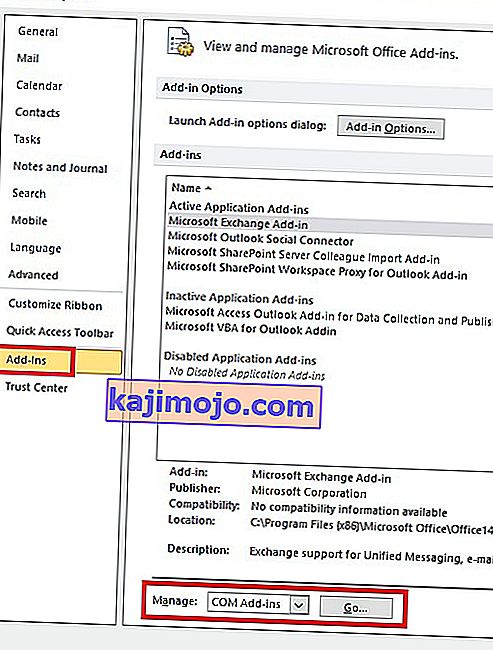
- Siinkohal peaksite tegema pistikprogrammide loendist ekraanipildi ja salvestama selle kuhugi sobivasse kohta. See aitab teil taastada oma Outlooki tavapärane konfiguratsioon, kui pärast lisandmoodulite keelamist ilmnevad tõrked.
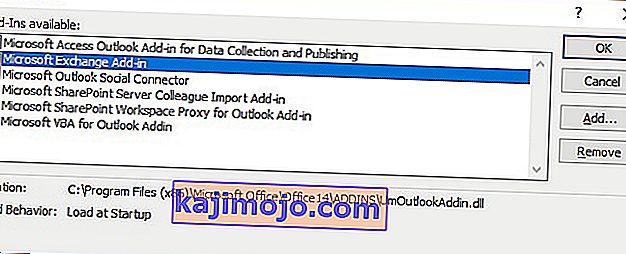
- Keelake iga kirje (tühjendage valitud ruudud) ja vajutage nuppu OK .
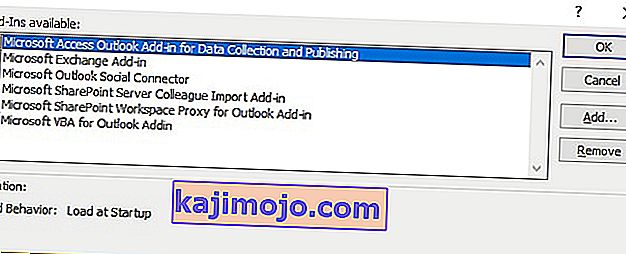 Märkus. Ärge klõpsake veel nuppu Eemalda . Kõigepealt peame kinnitama, et nemad põhjustavad probleemi.
Märkus. Ärge klõpsake veel nuppu Eemalda . Kõigepealt peame kinnitama, et nemad põhjustavad probleemi. - Sulgege Outlook ja avage see uuesti varundamiseks. Kui programm käivitub tavarežiimis, on teie probleem lahendatud.
Märkus. Juhul, kui see ikka jätkub turvarežiimis , minge jaotisse Failivalikud> Lisandmoodulid ja lubage uuesti 5. lisandmooduliga keelatud lisandmoodulid ja liikuge 2. meetodile .
- Naaske jaotisse Fail> Valik> Lisandmoodulid ja lubage iga lisandmoodul süstemaatiliselt ükshaaval uuesti, kuni paljastate vastuolusid põhjustava lisandmooduli .
- Valige see ja vajutage Eemalda .
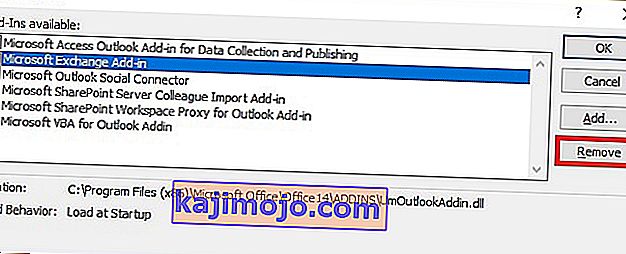
- Taaskäivitage Outlook ja vaadake, kas see käivitub tavarežiimis.
2. meetod: arvuti taastamine süsteemitaaste abil (kõik Outlooki versioonid)
Süsteemi taastamine on Windowsi funktsioon, mis võimaldab kasutajatel taastada arvuti olek eelmisele ajahetkele. See täidab meie eesmärki, kui suudame naasta olekusse, mis oli varasem kui Outlook hakkas valesti töötama. Tehke järgmist.
- Hoidke Windowsi klahvi ja vajutage R. Sisestage rstrui.exe ja klõpsake nuppu OK .
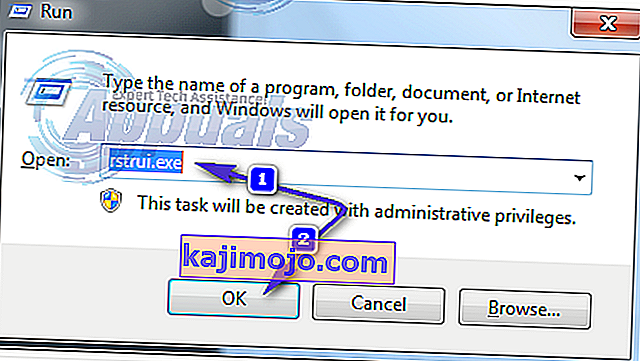
- Kui süsteemitaaste aken, valige Vali teine taastepunkti ja vajuta Next.
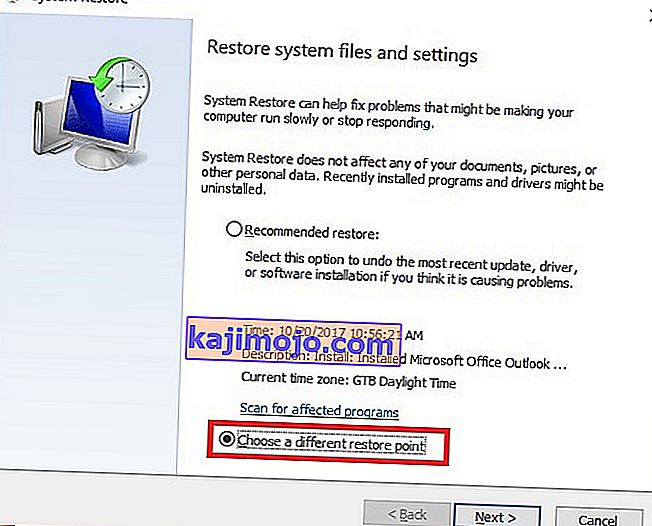
- Paksutage ruut valiku Kuva rohkem taastepunkte kõrval .
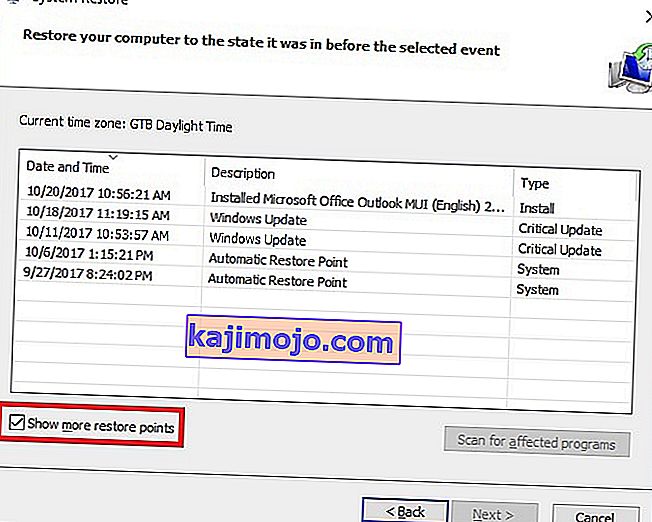
- Leidke punkt, kui Outlook töötas, seejärel valige see taastepunkt ja jätkake ekraanil olevate juhistega arvuti varasemaks taastamiseks.
- Kui see on tehtud, hakkab süsteem taastama. Pärast taastamise lõppu kontrollige, kas Outlook töötab. kui ei, siis jätkake 3. meetodiga .
3. meetod: taastage Outlooki eelmine versioon
Kui töölaua OS-i varasema versiooni taastamine ei õnnestunud, proovime Outlooki eelmise versiooni taastada. Nii toimige järgmiselt.
- Klõpsake nuppu Start ja tippige otsingudialoogi Outlook.exe . Paremklõpsake sellel ja valige Atribuudid .
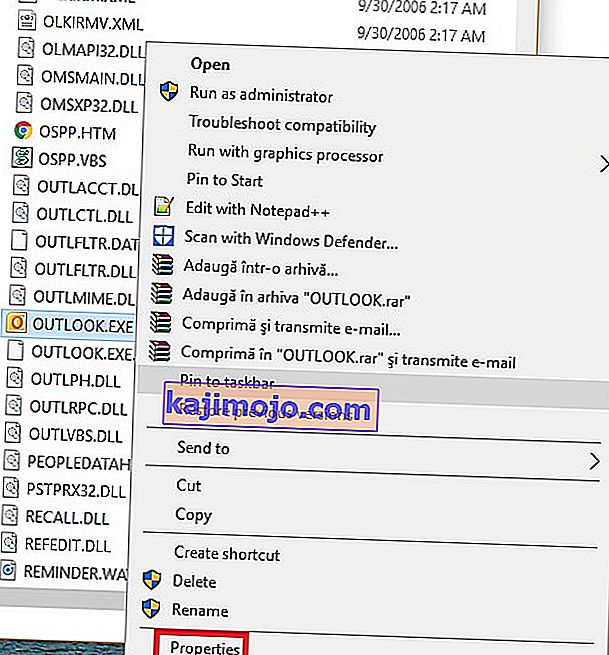
- Seejärel minge vahekaardile Eelmised versioonid ja leidke fail Outlook.exe, millel on töötamise kuupäev. Klõpsake nuppu Ava, et näha, kas see töötab ja avaneb ilma turvarežiimita .
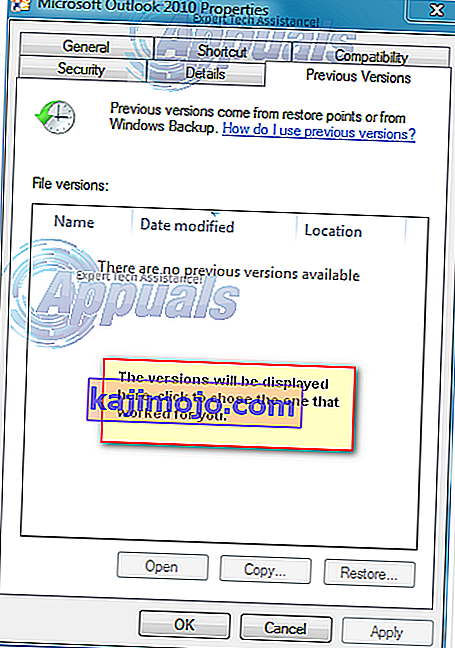 Märkus. Veenduge, et varem turvarežiimis avatud mittetöötav Outlook on suletud, kuna meil töötab nüüd üks eelmistesse versioonidesse salvestatud koopiaid. Tehke sama kõigi seal loetletud versioonide puhul. Avage / sulgege, kuni näete seda, mis avaneb ilma turvarežiimita. Kui see töötab, hoidke akent lahti.
Märkus. Veenduge, et varem turvarežiimis avatud mittetöötav Outlook on suletud, kuna meil töötab nüüd üks eelmistesse versioonidesse salvestatud koopiaid. Tehke sama kõigi seal loetletud versioonide puhul. Avage / sulgege, kuni näete seda, mis avaneb ilma turvarežiimita. Kui see töötab, hoidke akent lahti. - Eeldades, et nüüd töötab Outlooki versioon ilma ühest eelmisest versioonist turvarežiimita. Hoidke Windows Key ja vajutage R . Sisestage taskmgr ja klõpsake nuppu OK .
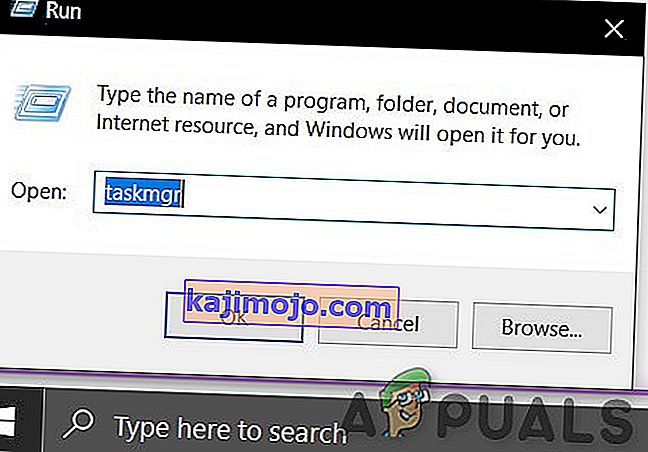
- In Task Manager aken, minge protsessi Tab, leida Outlook.exe paremklõps ja vali Open File Location.
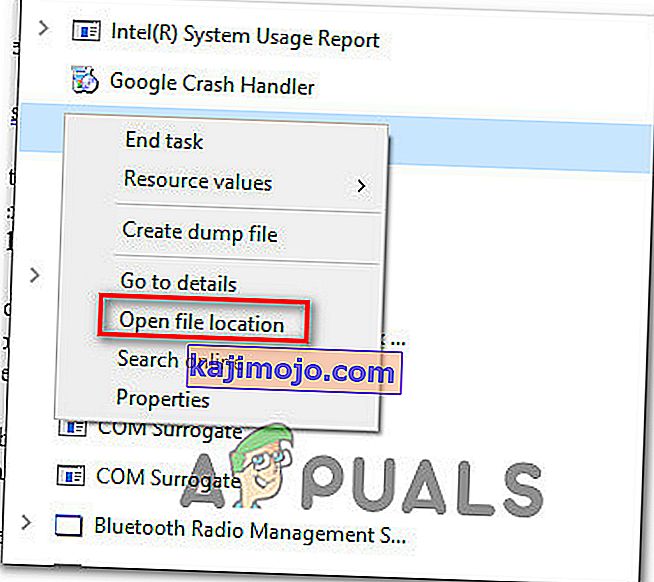
- Kopeerige kõik failid järgmisest aknast ja navigeerige jaotisse C: \ Program Files (x86) \ Microsoft Office \ Office. Kleepige siia varem kopeeritud fail.
- Proovige Outlook uuesti avada ja vaadake, kas see algab tavarežiimis.
4. meetod: värskenduse KB3114409 desinstallimine (Outlook 2010)
Millalgi 2015. aastal andis Microsoft välja turvapaiga, mis pani Outlooki turvarežiimis töötama ja taastas selle vaikekonfiguratsiooni. Kasutaja loodud konfiguratsioonid ei kao igaveseks ja need tulevad tagasi, kui Outlookil õnnestub tavarežiimis taaskäivitada.
Kui teil on selline probleem, saate edasi liikuda kahel viisil. Kuna Microsoft andis välja värskenduse, mis lahendab KB3114409 põhjustatud probleemi , saame selle halva värskenduse kaudu installida. Erinev tee oleks KB3114409 desinstallimine .
We highly recommend you to go for installing the official Microsoft update fix. But regardless of which option you opt for, we will guide you through the whole process.
Using the official Microsoft fix
Microsoft update KB3114560 was issued specifically to fix the damage done by KB3114409. As a rule of thumb, you should always install security updates from the official website. Here’s what you need to do:
- Access this official link and click on one of the two different update versions, according to your PC specs.
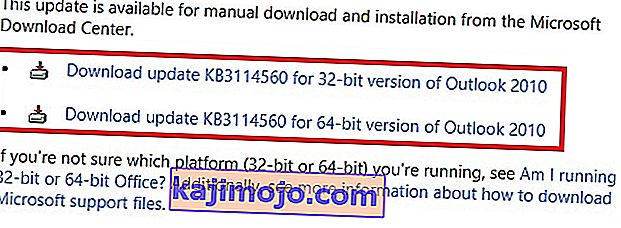
- Select the default language of your Outlook program and click on the Download button.
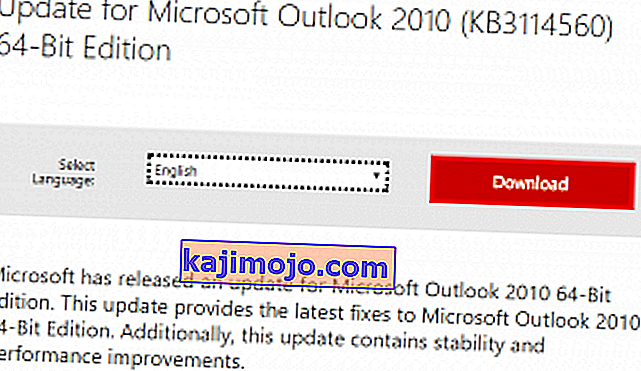
- Once the update has been downloaded, open the executable and follow through with the installation process.
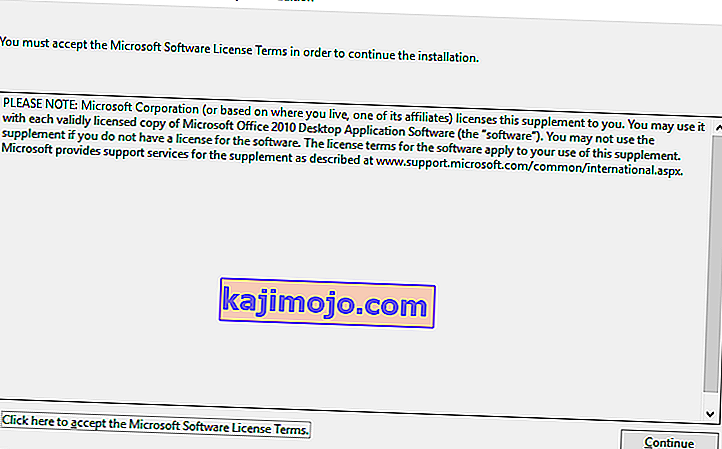
- Restart your PC, open Outlook again and see if the issue has been resolved.
Uninstalling the KB3114409 update
- Close Outlook completely.
- Open Control Panel, click on Uninstall a program.
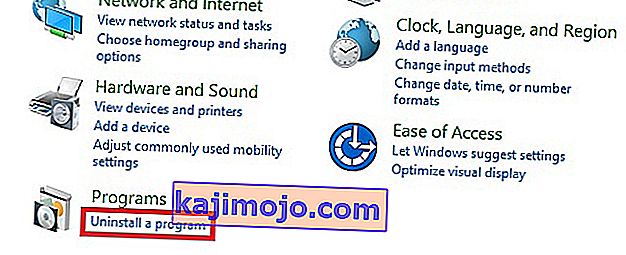
- Once you’re in the Programs and Features window, click on View installed updates.
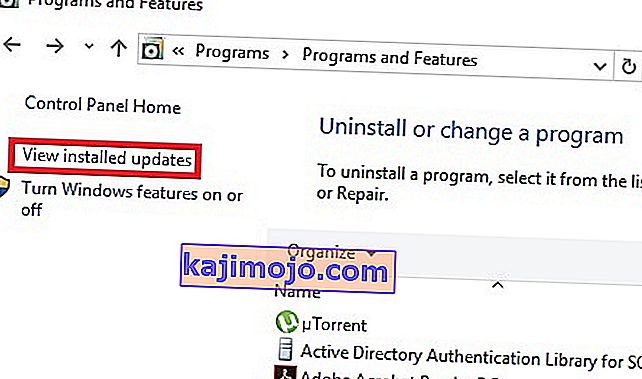
- Use the Search Installed Updates search bar in the top-right corner to search for the bad update (KB3114409 ).

- Once you manage to identify the bad update, click the Uninstall button and follow through with the confirmation prompts.
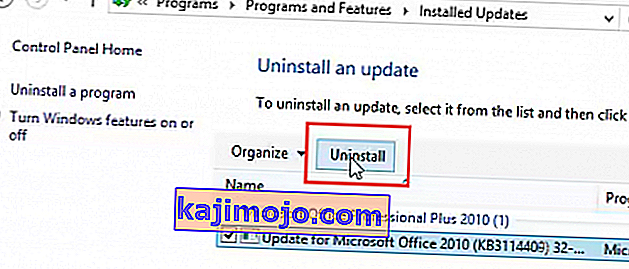
- Restart your PC, open Outlook and see if the issue repeats.
Method 5: Doing an Outlook Profile reset (All Outlook versions)
If you experience hanging at the initial Outlook splash screen (right before it initiates Safe Mode), you might need to do a profile reset. Here’s how to do it:
- Go to Control Panel > Mail and click on Show Profiles.
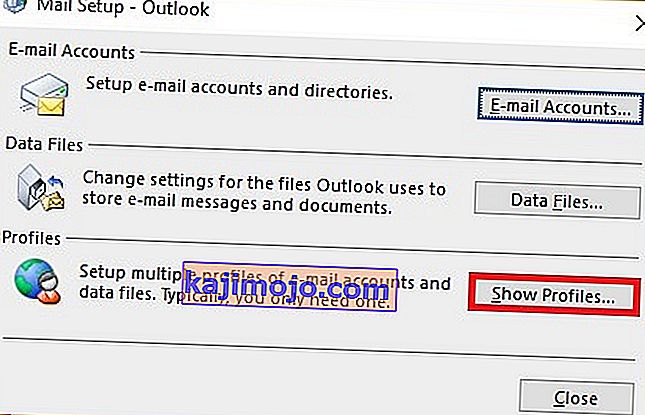
- Now, create a new profile by clicking the Add button. Insert a name and hit OK.
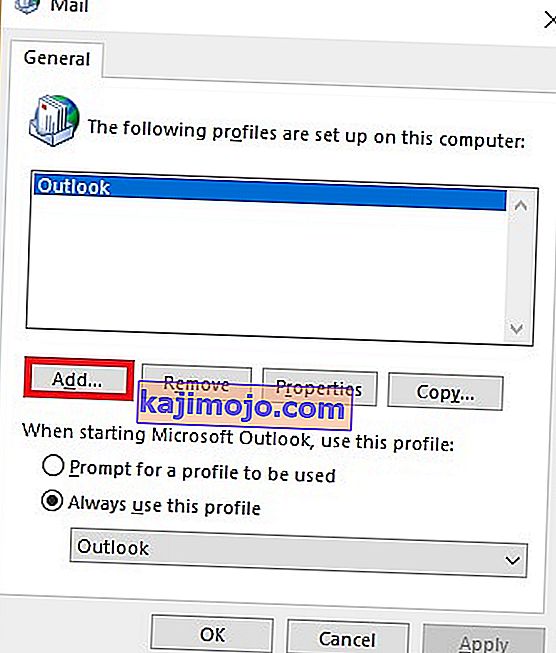
Note: Do not delete the original profile, because we don’t know if this will end up fixing the issue.
- Go through the steps of configuring your email account with Outlook. Make sure to use the same email that you have on the already created profile.
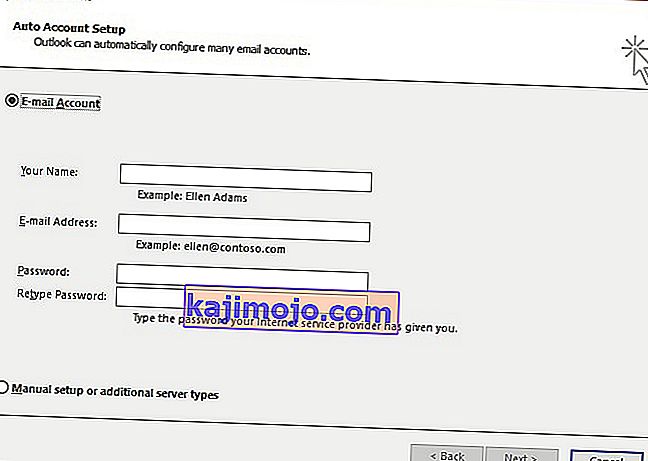
- Now return to the Mail window and make sure the profile you’ve just created is being used by default. Hit Apply to confirm your selection.
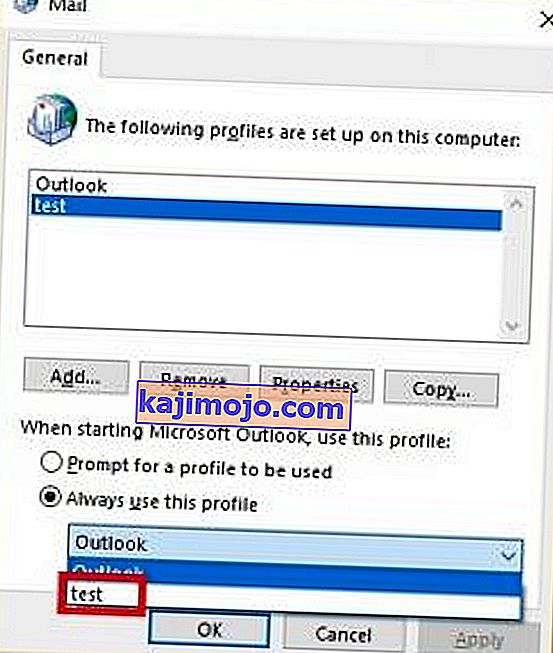
- Start Outlook again and see if it manages to start in normal mode after the profile reset.
Method 6: Checking the PST folder for corruption (All Outlook versions)
Another common cause for Outlook starting in Safe Mode is the Personal Folders File (PST). In the event that it becomes very large, or some files inside are corrupted, it might prevent the program from starting in normal mode. Luckily, you can easily check for corruption by using a Microsoft Repair tool called Scanpst.exe. Here’s what you need to do:
- Close Outlook completely and navigate to C:\ Program Files or C:\ Program Files (x86), depending on which version of Outlook you use.
- Use the search box in the top-right corner to search for SCANPST.exe.
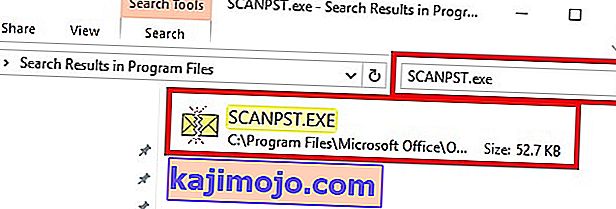 Note: If you don’t manage to find the SCANPST executable via the search bar, you need to navigate to the exact location. Here’s a list of the exact locations based on various Outlook versions:
Note: If you don’t manage to find the SCANPST executable via the search bar, you need to navigate to the exact location. Here’s a list of the exact locations based on various Outlook versions:2016: C:\Program Files (x86)\Microsoft Office\root\Office16 2013: C:\Program Files (x86)\Microsoft Office\Office15 2010: C:\Program Files (x86)\Microsoft Office\Office14 2007: C:\Program Files (x86)\Microsoft Office\Office12
- Open SCANPST.exe and set the path of the PST file you want to scan by using the Browse button. By default, the PST files are stored in Documents\Outlook Files. When you are ready, hit Start to begin the scan.
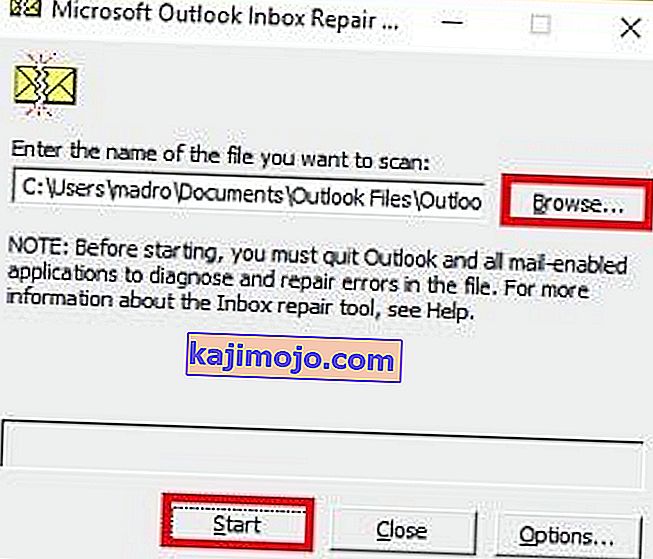
- If the scan uncovers errors or inconsistencies, click on the Repair button to fix them.
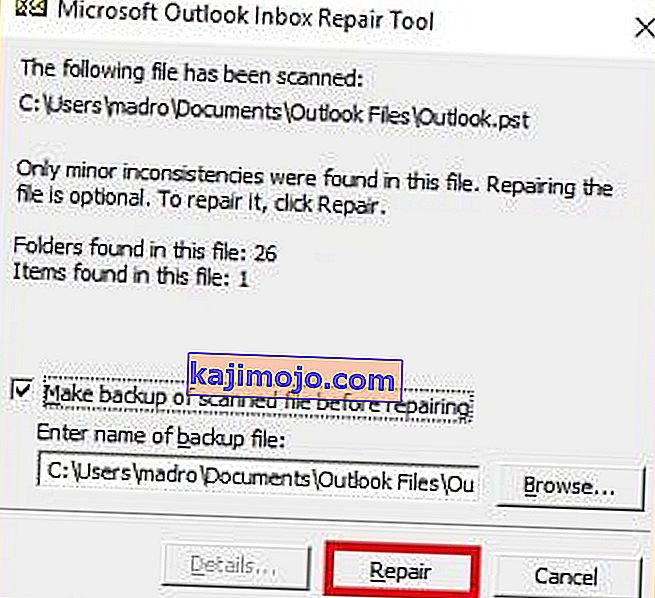
- Once the repair is done, restart Outlook with the profile that you’ve just repaired of errors and see if it starts in normal mode.
Method 7: Running the /resetnavpane command (All Outlook versions)
The navigation pane is that left portion of Outlook where you can oversee your folder list and access various icons to move between calendar, people, tasks, and mails. Sometimes, it can become glitched and prevent Outlook from starting in normal mode. Luckily, there is a command that removes any customizations to the navigation pane and gets rid of any glitch. Even better, this is done outside Outlook with ease. Here’s how:
- Close Outlook completely.
- Go to Start and access the Run application.
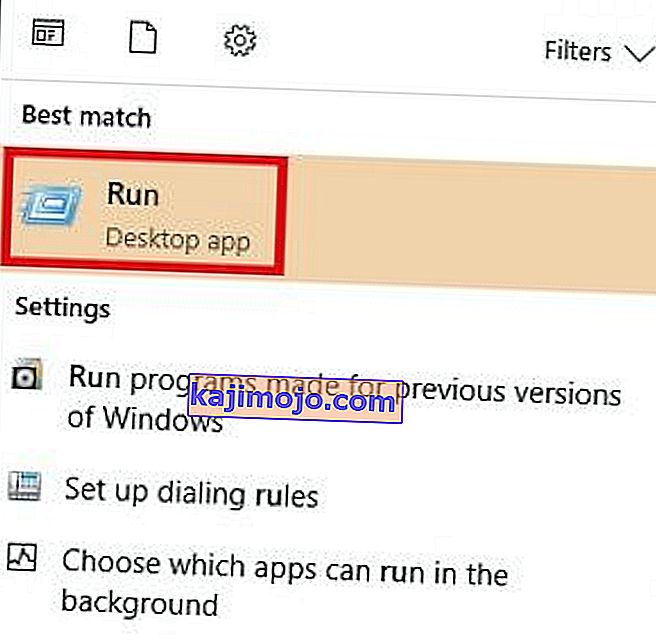
- Now, type Outlook.exe /resetnavpaneand hit OK.
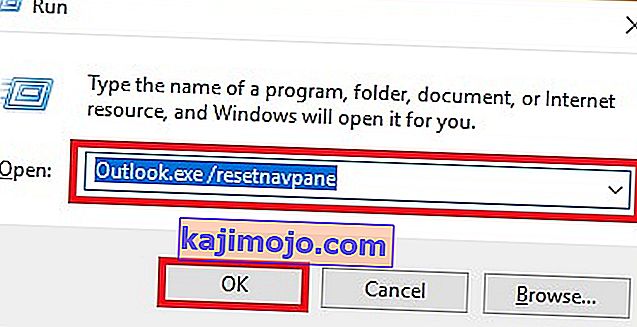 Note: Keep in mind that any customization to the navigation pane will be lost after you click on OK.
Note: Keep in mind that any customization to the navigation pane will be lost after you click on OK. - Shortly after, Outlook should automatically open in normal mode.
Method 8: Disabling compatibility mode
A lot of users have reported that they managed to start Outlook in normal mode after finding out it was running in compatibility mode. Compatibility mode is designed to help a program run as if it was running on an older operating system. As it turns out, turning off compatibility mode might just fix your Outlook Safe Mode problem. Here’s how:
- Close Outlook and navigate to the Outlook.exe on your computer. The exact path of it will differ, depending on your Outlook version. Here’s a list of the exact paths depending on your Outlook version:
2016 - C:\Program Files (x86)\Microsoft Office\root\Office16 2013 - C:\Program Files (x86)\Microsoft Office\Office 15 2010 - C:\Program Files (x86)\Microsoft Office\Office 14 2007: C:\Program Files (x86)\Microsoft Office\Office12

- Right-click on Outlook.exe and click on Properties.
- Now click on the Compatibility tab and make sure the box directly under Compatibility Mode is unchecked. Hit Apply to confirm your selection.
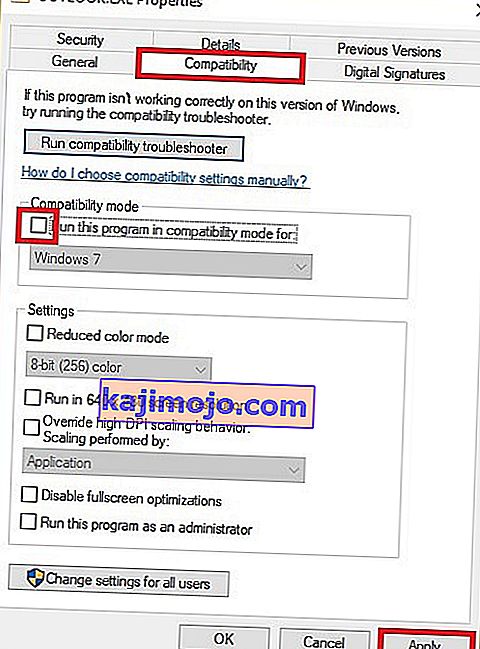
- Finally, open Outlook from the same Outlook executable and see if it manages to start in normal mode.
Method 9: Disabling hardware acceleration (All Outlook versions)
As it turns out, Outlook tries to use hardware acceleration whenever it can to make things as seamless as possible. If you’re Outlook forces itself into Safe Mode, it could very well be an issue with hardware acceleration. We can check to see if that’s the case by making some minor tweaks inside regedit. Here’s how:
- Go to Start and open the Run application.
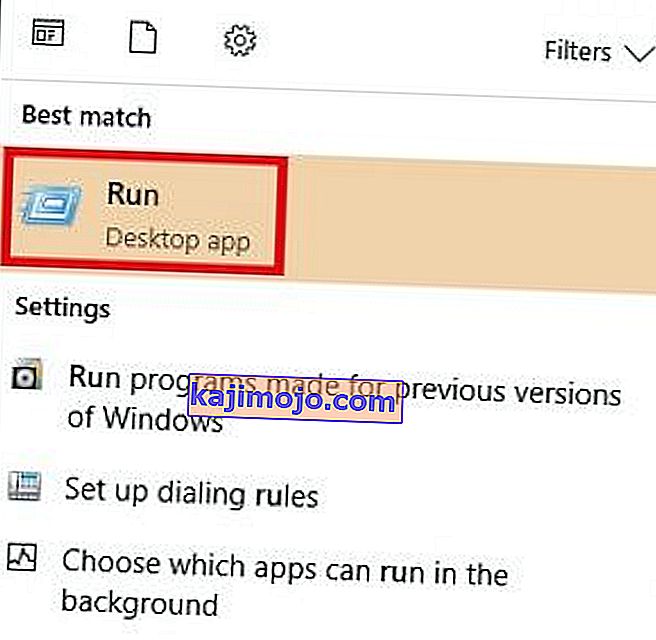
- Search for regedit and click OK to open the Registry Editor.

- Navigate your way to the following location
HKEY_CURRENT_USER\ Software\ Microsoft\ Office.
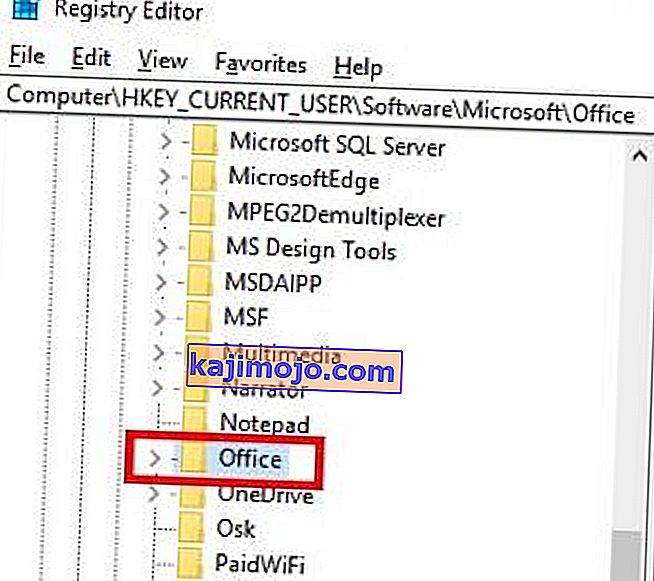
- Now, depending on which Outlook version you have, you might encounter different folders. You should either see a folder named 14.0, 16.0 or 8.0. Either way, click on the folder and double-click on the Common folder.
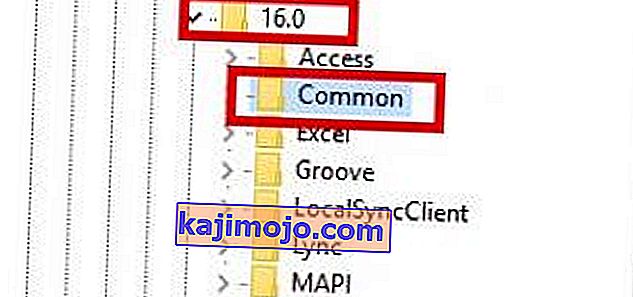
- Right-click anywhere in the Common folder, select New and click on Key and name it Graphics.
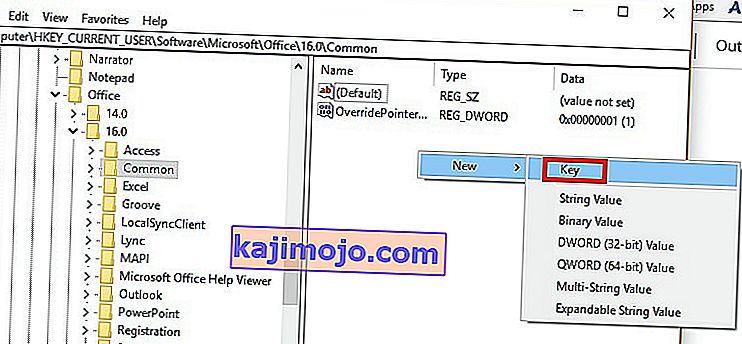
- Select the newly created Graphics folder and right-click on the right panel. From there, create a New Dword (32-bit) Value and name it DisableHardwareAcceleration.
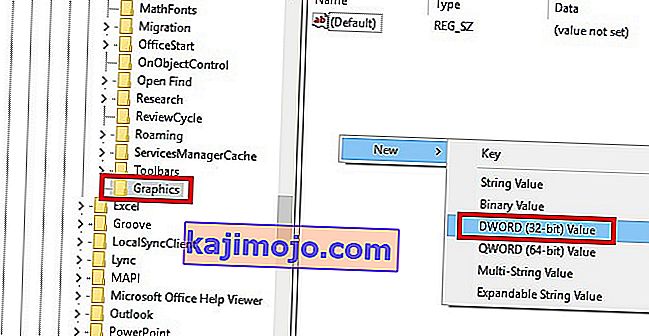
- Now double-click on DisableHardwareAcceleration and set the Value Data to 1 and hit Ok.
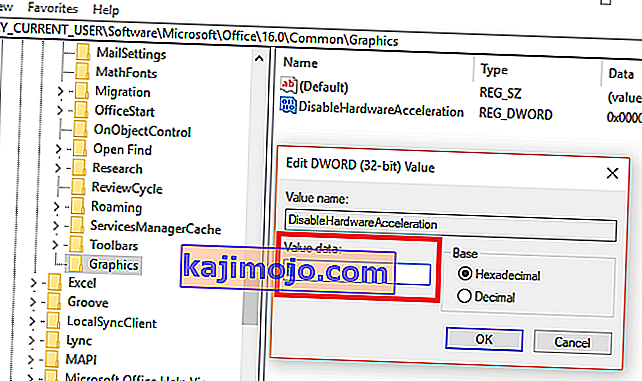
- Close regedit and open Outlook again to see if it starts in normal mode.
Method 10: Resetting the Safe Mode Registry Key (Outlook 2010)
If you have unsuccessfully followed all the methods above, there’s one more thing you can try. A final solution would be to try and prevent Safe Mode from kicking in by tweaking the registry key. But keep in mind that after you’ll follow the steps below, you won’t be able to use Safe mode in the future. At least not until you remove the key that we will create. Here’s what you need to do:
- Go to Start and open the Run application.

- Search for regedit and click OK.

- Navigate your way through HKEY_CURRENT_USER\ Software\ Microsoft\ Office.

- Now, depending on which Outlook version you have, you might encounter different folders. You should either see a folder named 14.0, 16.0 or 8.0. Either way, click on the folder navigate further to Outlook \ Security.
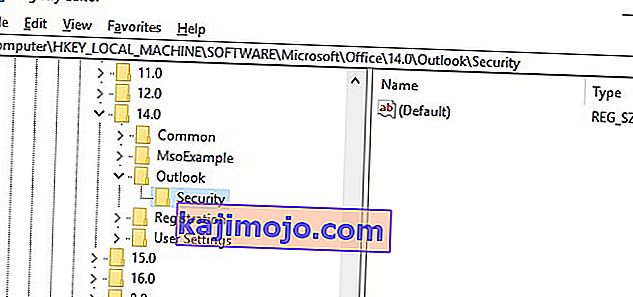 Note: If the Security folder is missing, Right-click > New > Key and type Security.
Note: If the Security folder is missing, Right-click > New > Key and type Security. - Right-click on the Security key and choose New > then DWORD (32-bit) Value.
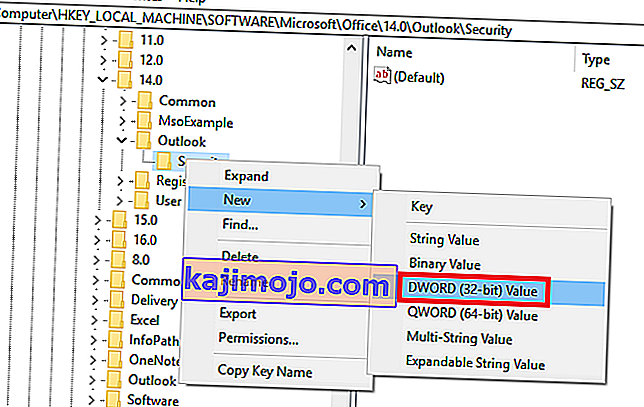
- Name it DisableSafeMode and press Enter to confirm.
- Right-click on DisableSafeMode and click on Modify.
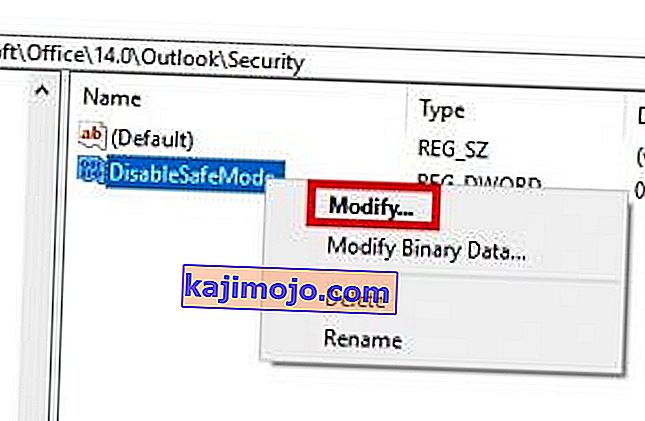
- Sisestage väärtus 1 aasta Value data ja klõpsake OK .

- Sulgege registriredaktor ja taaskäivitage arvuti.
- Avage Outlook ja vaadake, kas see käivitub tavarežiimis.






 Märkus. Ärge klõpsake veel nuppu Eemalda . Kõigepealt peame kinnitama, et nemad põhjustavad probleemi.
Märkus. Ärge klõpsake veel nuppu Eemalda . Kõigepealt peame kinnitama, et nemad põhjustavad probleemi.




 Märkus. Veenduge, et varem turvarežiimis avatud mittetöötav Outlook on suletud, kuna meil töötab nüüd üks eelmistesse versioonidesse salvestatud koopiaid. Tehke sama kõigi seal loetletud versioonide puhul. Avage / sulgege, kuni näete seda, mis avaneb ilma turvarežiimita. Kui see töötab, hoidke akent lahti.
Märkus. Veenduge, et varem turvarežiimis avatud mittetöötav Outlook on suletud, kuna meil töötab nüüd üks eelmistesse versioonidesse salvestatud koopiaid. Tehke sama kõigi seal loetletud versioonide puhul. Avage / sulgege, kuni näete seda, mis avaneb ilma turvarežiimita. Kui see töötab, hoidke akent lahti.












 Note: If you don’t manage to find the SCANPST executable via the search bar, you need to navigate to the exact location. Here’s a list of the exact locations based on various Outlook versions:
Note: If you don’t manage to find the SCANPST executable via the search bar, you need to navigate to the exact location. Here’s a list of the exact locations based on various Outlook versions:


 Note: Keep in mind that any customization to the navigation pane will be lost after you click on OK.
Note: Keep in mind that any customization to the navigation pane will be lost after you click on OK.








 Note: If the Security folder is missing, Right-click > New > Key and type Security.
Note: If the Security folder is missing, Right-click > New > Key and type Security.

